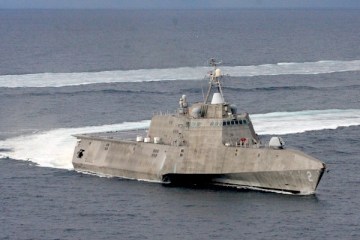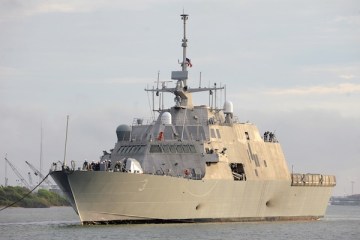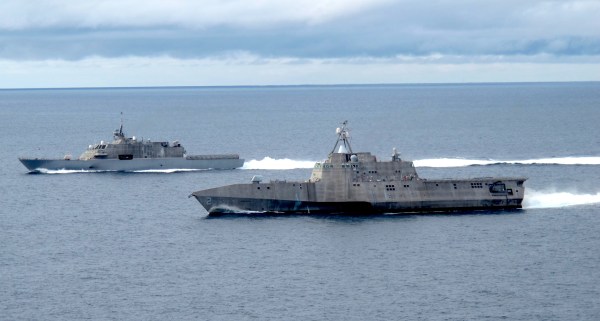The first two Littoral Combat Ships: the USS Freedom, rear, and the USS Independence, off the California coast. The ships primarily are designed to engage in combat close to shore.
The Navy’s new Littoral Combat Ship (LCS) is not only staggeringly overpriced and chronically unreliable but — even if it were to work perfectly — cannot match the combat power of similar sized foreign warships costing only a fraction as much. Let’s take a deep dive and try to figure out why.
The story so far:
— Congress has funded the LCS program since February 2002. Its publically stated purpose was to create a new generation of surface combatants able to operate in dangerous shallow water and near-shore environments.
— By December 2009 the Navy had built two radically dissimilar prototypes, the mono-hulled USS Freedom (LCS-1) and the trimaran-hulled USS Independence (LSC-2).
— A year later it adopted both designs and decided to award block buy construction contracts for five more ships of each type.
— Since neither design had yet proven either its usefulness or functionality it seems that the Navy’s object was to make the LCS program “too big to fail” as soon as possible.
— It may be working: the 55-ship fleet is slated to cost more than $40 billion, giving each vessel a price tag north of $700 million, roughly double the original estimated cost.
Both LCS designs were supposed to be small (about 3,000 tons displacement), shallow-draft coastal warships that relied on simplicity, numbers and new technology to stay affordable and capable throughout their service lives.

Navy photo / Lt. Jan Shultis
The new technology was mainly robotics (unmanned air, surface and underwater vehicles) and modular weapons and sensors. The modular systems were a series of mission payload packages or modules; each designed to fit a common cargo/weapons bay or slot and focus the ship on a specific mission.
When the ship’s mission changed it could quickly swap its current module for one that supported the new mission. This was a way to combine the advantages of both single and multi-mission platforms.
Foreign navies had already applied the concept successfully. The Danish Navy’s “Standard Flex” series of weapon modules had in particular grabbed the U.S. Navy’s attention.
Each LCS also has a flight deck and hangar able to accommodate up to two H-60 helicopters or up to four MQ-8B helicopter drones (one helicopter and two to three drones would be a typical mix). In addition, an LCS can carry and operate surface and sub-surface drones. Current modules in development are for mine warfare (MIW), anti-submarine warfare (ASW) and anti-surface warfare (ASUW).
The MIW and ASW modules are mostly sensors with only drone or helicopter launched weapons. The ASUW module is focused mainly on defeating speedboats and offers only two 30mm MK-46 guns and some short-ranged low payload Griffin missiles. None of these modules will even be testable until well into FY13 and none will be operational before FY16.
Outside of the modules an LCS has a permanent armament of a 57mm MK-110 automatic gun, some 0.50-caliber machineguns and a close defense missile system (RIM-116 SeaRAM).
Even with its modules the LCS compares poorly with similar-sized but much less expensive ships in foreign navies.
The new Russian Steregushchy–class frigate, for example, is (at 2,200 tons) about 30% smaller than an LCS and cost only 20-25% as much. Yet, it carries a 100mm automatic gun, 14.5-mm machineguns, close-in defense “Gatling gun” systems (AK-630), medium range surface to air missiles (S400 series), SS-N-25 anti-ship missiles (sub-sonic and shorter ranged than the US Harpoon but far more capable than the Griffin), 533-mm (21”) torpedoes, 324mm anti-submarine torpedoes and a helicopter. The ship is not only in production for the Russian Navy but also for the navies of Algeria and Indonesia. A version is also being built for China.
The Swedish Visby–class corvette was one of the models on which LCS was based. It carries the same 57mm gun plus antisubmarine rockets and torpedoes, anti-ship missiles, a radar-deflecting hull, and a helicopter pad (but no hangar, apparently). It can also reach 35 knots but it is only a fifth as large.
The Chinese have more than 80 Houbei–class fast-attack boats in service. Each costs only $40 million to build and displaces only 220 tons (one-fifteenth as much as an LCS). Yet they carry C-801 series anti-ship missiles that greatly outrange any weapon the LCS has.
About the only threat the LCS might handle is the “swarms” of Iranian machinegun and RPG-carrying speedboats in the Persian Gulf. Apart from the fact that the Iranian crisis will have been resolved for better or worse before most of the LCS fleet can be built, these Iranian small craft lack weapons big enough to menace any serious warship.

Navy photo / MCS 2nd Class Rosalie Garcia
However the LCS itself may be more vulnerable to these speedboats than the ships it is protecting from them. This is because the ballooning LCS construction costs caused the Navy to try to save money by ordering that future ships be built to commercial standards.
This will reduce their survivability level (protection of ship, crew, and vital systems) to (or below) the lowest level (of three) the Navy recognizes. Survivability testing has been cancelled, as it would cause too much damage to the test ship. Instead, the LCS is rated as not survivable in a “hostile combat environment.”
Worse, the Navy has admitted that, unlike the foreign systems they were modeled on, LCS modules will not be swappable within day or two as originally envisaged. Instead, the process can take weeks. Practical and political limitations on storing modules and supporting them overseas are likely to make module swapping possible only in U.S. shipyards. An LCS entering a combat theater will have to be in a single “come as you are” configuration that cannot adapt to mission changes.
The LCS does lead its foreign competitors when it comes to speed. At the Navy’s insistence, each LCS carries a set of diesels for cruising. It also has a suite of gas turbines that can at least for short spurts propel it at speeds as high as 50 knots.
By contrast the LCS’ foreign competitors rarely exceed 35 knots (the heavily-armed Steregushchy is only good for 26). However, speed at sea is a terribly expensive capability. Except for large nuclear-powered ships, very high speeds are only possible for limited times and in good weather. Incremental speed increases require geometric horsepower increases. Gas turbines generating more than 100,000 horsepower and their associated fuel tanks must leave the LCS little space for armor, weapons, sensors or crew accommodations. Though the Navy has not said so, it is likely that these gas turbines have been the source of many of the LCS’ mechanical problems.
Why is high speed so important? Even high-speed minesweeping does not require more than 25 knots or so. For chasing small boats the LCS’s size advantage will let it catch nominally faster craft if any kind of sea is running. If this is not enough, the LCS has its helicopters and drones. The LCS may need speed to deploy quickly over long distances but is unlikely to need it for tactical maneuver. Without its gas turbines the LCS could be small (and cheaper), like the Visby, or powerfully-armed, like the Steregushchy. Instead, it is neither.
When asked why the LCS has sacrificed so much for speed, Navy spokesmen tend to become vague. In a recent interview, Rear Admiral Thomas Rowden, the Navy’s chief of surface warfare, could only explain the LCS’ speed requirement with clichés such as “speed is life” (is the LCS really an airplane? Does it outrun cruise missiles?) or “more is better” (more speed but less of everything else?). He even quoted John Paul Jones asking for a fast ship to go “in harm’s way.” Such fatuous statements might satisfy a fourth-grade civics class but this contemptuous dismissal of legitimate taxpayer concerns speaks volumes about what the Navy thinks of the people who ultimately pay its bills.
The surface-warfare chief went on to say that the Navy had yet to settle key LCS issues regarding missions, tactics and the design features to support them. In a sane world, such issues would have been ironed out before any ships were built. Once they are settled, the results will have to be applied to existing ships (to the extent that is possible) at enormous cost. Such are the effects of a “build first, design later” shipbuilding policy.
The level of incompetence the Navy has displayed with the LCS is truly breathtaking.
The LCS was supposed to be small and cheap, able to relieve larger more expensive ships of secondary tasks and to dominate coastal “brown water” environments. Yet, it is not cheap. Construction costs have ballooned to more than triple their original estimates. It is incredibly extravagant for some of its missions (those than any Coast Guard cutter could do), and very inadequate for most of the others. Its MIW and ASW capabilities are only those of the aircraft it carries. Even with its ASUW module, its firepower falls far short of foreign ships one-fifth the size. Its RIM-116 lacks the range to protect other ships. Its 57mm gun is short-ranged and cannot support troops ashore.
Taxpayers – and Navy personnel, past and present — may better appreciate the scope of the LCS disaster when reminded that current plans call for these pseudo-warships to comprise more than a third of the Navy’s surface combatants by 2020.
Nevertheless, the Navy is not worried. Congress will bail them out and ensure the LCS program yields some sort of product, even if it is a terribly overpriced and only marginally meets program requirements.
Meanwhile, foreign — not necessarily friendly — navies are building better and cheaper ships.
John Sayen retired from the Marine Corps in 2002 as a lieutenant colonel. He currently works in the defense industry and occasionally writes on current and historical military and naval issues.

U.S. Navy / Lt. Jan Shultis


